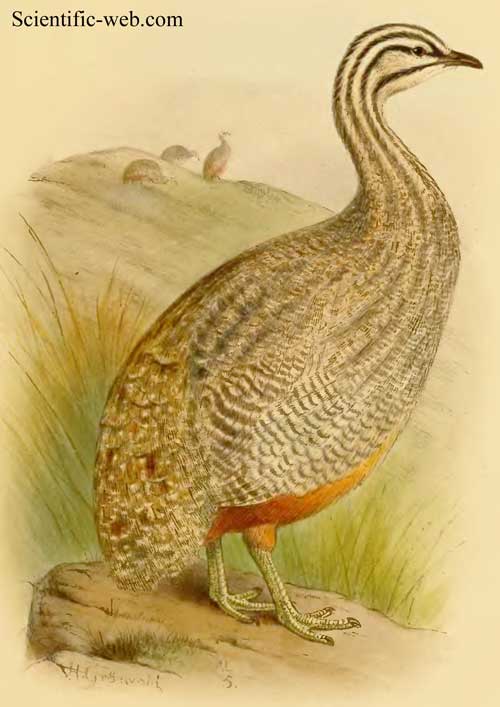
Tinamotis pentlandii
Superregnum: Eukaryota
Cladus: Unikonta
Cladus: Opisthokonta
Cladus: Holozoa
Regnum: Animalia
Subregnum: Eumetazoa
Cladus: Bilateria
Cladus: Nephrozoa
Superphylum: Deuterostomia
Phylum: Chordata
Subphylum: Vertebrata
Infraphylum: Gnathostomata
Megaclassis: Osteichthyes
Cladus: Sarcopterygii
Cladus: Rhipidistia
Cladus: Tetrapodomorpha
Cladus: Eotetrapodiformes
Cladus: Elpistostegalia
Superclassis: Tetrapoda
Cladus: Reptiliomorpha
Cladus: Amniota
Classis: Reptilia
Cladus: Eureptilia
Cladus: Romeriida
Subclassis: Diapsida
Cladus: Sauria
Infraclassis: Archosauromorpha
Cladus: Crurotarsi
Divisio: Archosauria
Cladus: Avemetatarsalia
Cladus: Ornithodira
Subtaxon: Dinosauromorpha
Cladus: Dinosauriformes
Cladus: Dracohors
Cladus: Dinosauria
Ordo: Saurischia
Cladus: Eusaurischia
Cladus: Theropoda
Cladus: Neotheropoda
Cladus: Averostra
Cladus: Tetanurae
Cladus: Avetheropoda
Cladus: Coelurosauria
Cladus: Tyrannoraptora
Cladus: Maniraptoromorpha
Cladus: Maniraptoriformes
Cladus: Maniraptora
Cladus: Pennaraptora
Cladus: Paraves
Cladus: Eumaniraptora
Cladus: Avialae
Infraclassis: Aves
Cladus: Euavialae
Cladus: Avebrevicauda
Cladus: Pygostylia
Cladus: Ornithothoraces
Cladus: Euornithes
Cladus: Ornithuromorpha
Cladus: Ornithurae
Cladus: Carinatae
Parvclassis: Neornithes
Cohors: Palaeognathae
Ordo: Tinamiformes
Familia: Tinamidae
Subfamilia: Rhynchotinae
Genus: Tinamotis
Species: Tinamotis pentlandii
Name
Tinamotis pentlandii Vigors, 1837: 79
References
Vigors, N.A., 1837: Proceedings of the Zoological Society of London. 4(45): 79–83. BHL [original description: p. 79]
Vernacular names
čeština: Tinama náhorní
English: Puna Tinamou
lietuvių: Paprastasis tinamas
svenska: Punatinamo
The puna tinamou (Tinamotis pentlandii) also known as Pentland's tinamou, is a member of the most ancient groups of bird families, the tinamous. This species is native to southern South America.[3] The binomial name of the species commemorates the Irish natural scientist Joseph Barclay Pentland (1797–1873) by Nicholas Aylward Vigors in 1837. The IUCN list this species as Least Concern,[1] with an occurrence range of 590,000 km2 (230,000 sq mi).[4]
Taxonomy
This is a monotypic species.[3] All tinamou are from the family Tinamidae, and in the larger scheme are also ratites. Unlike other ratites, tinamous can fly, although in general, they are not strong fliers. All ratites evolved from prehistoric flying birds, and tinamous are the closest living relative of these birds.[5]
Description
The puna tinamou is approximately 41 cm (16 in) in length. Its upper parts are brown spotted with white, and its breast is blue-grey, and its belly is rufous. Its head is white with black streaks.
Distribution and habitat
The puna tinamou inhabits high-altitude grassland, and to a lesser extent, brushland[1] at altitude 4,000 to 4,700 m (13,100–15,400 ft) of subtropical and tropical regions.[4] Its range is Peru, northern Bolivia, northern Chile and northwestern Argentina.[3]
Footnotes
BirdLife International (2016). "Tinamotis pentlandii". IUCN Red List of Threatened Species. 2016: e.T22678299A92766253. doi:10.2305/IUCN.UK.2016-3.RLTS.T22678299A92766253.en. Retrieved 11 November 2021.
Brand, S. (2008)
Clements, J. (2007)
BirdLife International (2008)
Davies, S. J. J. F. (2003)
References
BirdLife International (2008). "Puna Tinamou - BirdLife Species Factsheet". Data Zone. Retrieved 12 Feb 2009.
Brands, Sheila (Aug 14, 2008). "Systema Naturae 2000 / Classification, Genus Tinamotis". Project: The Taxonomicon. Retrieved 12 Feb 2009.
Clements, James (2007). The Clements Checklist of the Birds of the World (6th ed.). Ithaca, NY: Cornell University Press. ISBN 978-0-8014-4501-9.
Davies, S.J.J.F. (2003). "Tinamous". In Hutchins, Michael (ed.). Grzimek's Animal Life Encyclopedia. Vol. 8 Birds I Tinamous and Ratites to Hoatzins (2nd ed.). Farmington Hills, MI: Gale Group. pp. 57–59. ISBN 0-7876-5784-0.
Retrieved from "http://en.wikipedia.org/"
All text is available under the terms of the GNU Free Documentation License

